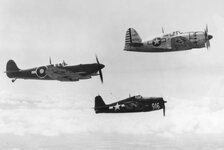Wild_Bill_Kelso
Senior Master Sergeant
- 3,231
- Mar 18, 2022
It was 32 feet 8 inches in length which isn't amazingly short.
It was just very wide because it had a very large diameter Mitsubishi Kasei engine normally considered a "Bomber Engine" buried deep in the fuselage.
The variant of the Seafire in the same photograph is about 2.5 feet shorter.
- Ivan.
https://acesflyinghigh.files.wordpr...en_in_the_philippines_taic_in_flight_1945.jpg
Very interesting, I never realized that, always thought it was short and fat... I hadn't considered the position of the engine etc.

